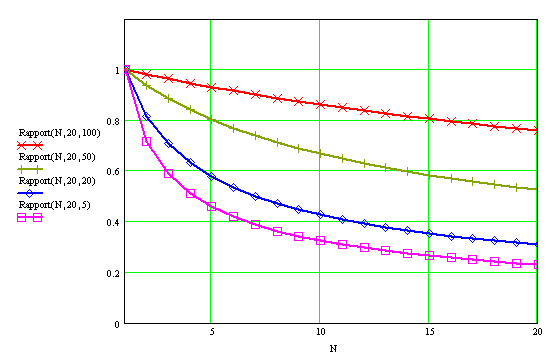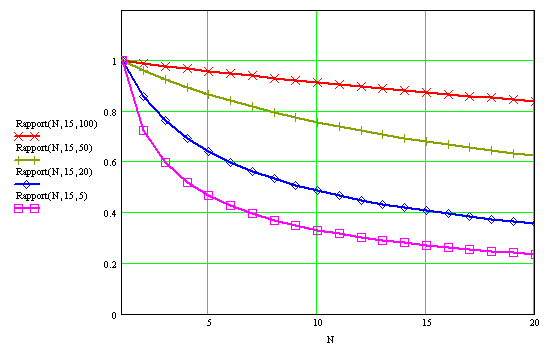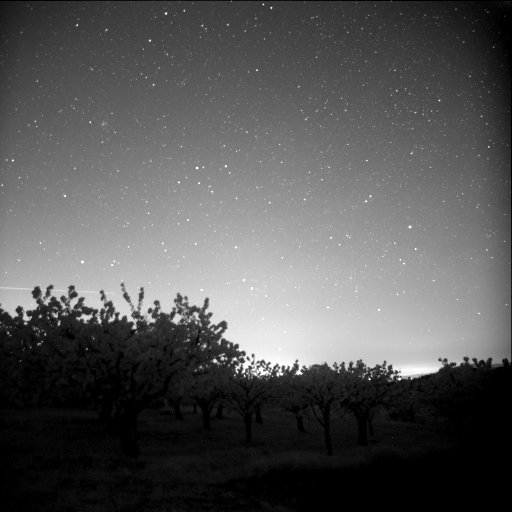 Image recorded with a 20 mm
lens, 2x2K CCD, 30 sec exposure. The lights from Rhone Valley towards west are
easly visible by naked eye.
Image recorded with a 20 mm
lens, 2x2K CCD, 30 sec exposure. The lights from Rhone Valley towards west are
easly visible by naked eye. THE SKY BACKGROUND
This is an issue related to all observatories, how sky background degrades ability to detect faint stars for long CCD exposures. This sky brightness is expressed in Magnitude per square arcsec for a given bandwidth (U, B,V,R and I standards). This means that every arcsec square of the sky shines like a star with a given Magnitude.
For instance
at Cerro Tololo, in 1988 the figures at near sunspot minimum
1987-1988, from measurements by A. Walker are the following :
|
Band
|
Magnitude
per square arcsec
|
|
U
|
22.0
|
|
B
|
22.7
|
|
V
|
21.8
|
|
R
|
20.9
|
|
I
|
19.9
|
For an unfiltered front side CCD observation, R filter has to taken into account for comparisons. Those figures can vary according to many parameters : Sky transparency, High elevation clouds, City in the nearby (light pollution) etc. etc. ...Anyway, this is a very good observing place to get 21 in R band.
 Image recorded with a 20 mm
lens, 2x2K CCD, 30 sec exposure. The lights from Rhone Valley towards west are
easly visible by naked eye.
Image recorded with a 20 mm
lens, 2x2K CCD, 30 sec exposure. The lights from Rhone Valley towards west are
easly visible by naked eye.
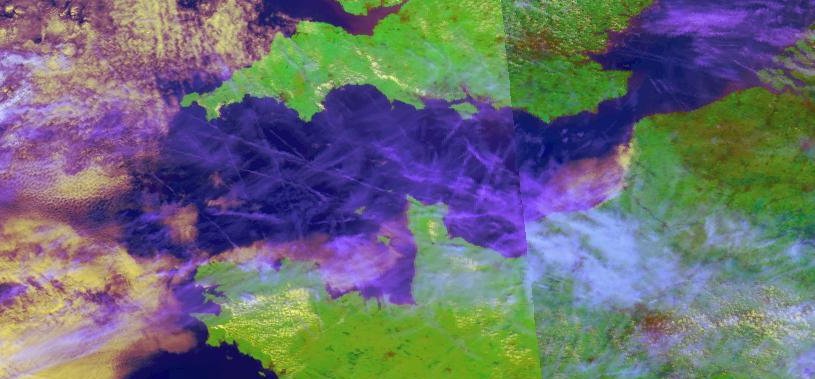 Another wird pollution concerns
planes contrails... recorded by May 29th, 2001
Another wird pollution concerns
planes contrails... recorded by May 29th, 2001
Hereafter, a table providing figures for many observing place I was visiting. Please note that those figures can change according to the season, to meteorological conditions.... etc, etc
|
Observatory
|
Location
|
Magnitude
per square arcsec (R band)
|
|
Pises
Obs.
|
South
of France, 1300m elevation, pretty dark place. GARD
|
19.5 to 20
|
|
Les
Angarouines
|
Country
side Observatory, South of France, 30km from Rhone Valley, VAR
|
19
to 19.5
|
|
Garching
|
Suburb
place, 15 kms north from Munich (1M inhabitants), BAYERN
|
18.5
to 19
|
|
VALMECA
Obs.
|
Countryside
Observatory, South of France, 30km from Durance Valley, ALPES DE HAUTE
PROVENCE
|
19
to 19.5
|
|
Pic
du Midi Obs.
|
South
of France, 2870m elevation, pretty dark place. HAUTES PYRENEES
|
TBD
|
|
Toulouse
|
5
km appart from center
|
17.5
|
To compute the
sky background, the first step is to perform a photometry calibration using
the USNO SA2 catalog.
For that purpose, you can use a CCDimage recorded with a telescope pointing
to the zenith, do not point through the MilkyWay and use a focal length greater
than 500mm.
The image needs to be preprocessed, i.e. : flat, offset and dark contributions
must be removed : This is very important otherwise, the measurement will end
up to be incorrect.
Once the calibration is achieved, one has to measure the magnitude of a star (or many to decrease the errors). For instance, a star of Mg 13.2 will provide 40000 counts (adus). The final step is to measure the sky background for a given pixel, for instance 630 adus per pixel in average. Then apply the following formulae. You have to know the pixel scale (i.e. 1 pixel is 2.05 arcsec in the sky).
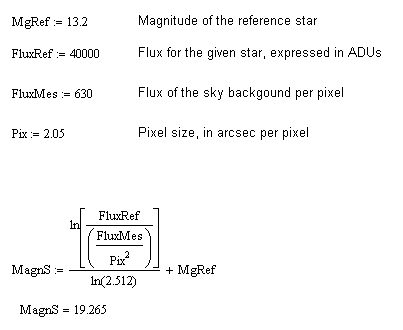
All measurement were carried out by PRiSM v4
How sky background effects deep sky imaging ? And how it has an effect to single exposure splitting ?
This is a very common practice to split CCD exposure instead of making a single one : for instance an 1/2 hour exposure can be splitted in N single exposures like N=10 times 3 minutes exposures.
Nevertheless, this has an impact because of the readout noise of the CCD, and the Signal to noise Ratio (SNR) degradation can be expressed as the following :

where N is the amout of CCD readouts, NoiseBackground is the SKY background noise expressed in ADU or Electrons, NoiseCamera can be also expressed in ADU or electrons, but they need both to be expressed in electrons or ADU, don't mix the units up !
So, there is too cases : the first one occurs where the SKY bacground dominates the CCD readout noise and the other is when CCD readout noise is comparable to SKY bacground noise (this can happen in spectroscopy or when using low bandwith optical filters ).
The following plot illustrates the 1st case: readout noise is 20e-, and Sky background is 400, 1000 and 4000 e- noise per pixel. The image stacking of 20 single exposures will degrade the SNR of less than 3% in the worst case (only 400e- noise of sky background) compared to a 20 time longer single exposure image.
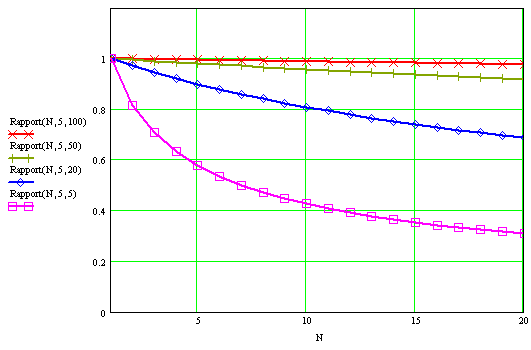
The next set of plots illustrates the 2nd case: CCD readout noise is 20, 10 and 5 e-, and Sky background is 5, 20, 50 and 100 e- noise per pixel. The image stacking of 20 single exposures degrades in all cases the SNR compared to a 20 time longer single exposure image. For instance, a Sky background of Magnitude 19 per square arsec will provide around 50e- noise for a 100 sec exposure, if the CCD readout is 15e- to stack 10 exposures (=equivalent to a 1000sec exposure) will yield to a loss of SNR of 25%, to stack 5 exposures ( equivalent=500s) will yield to a loss of SNR of 15% compared to a single 500s exposure.
